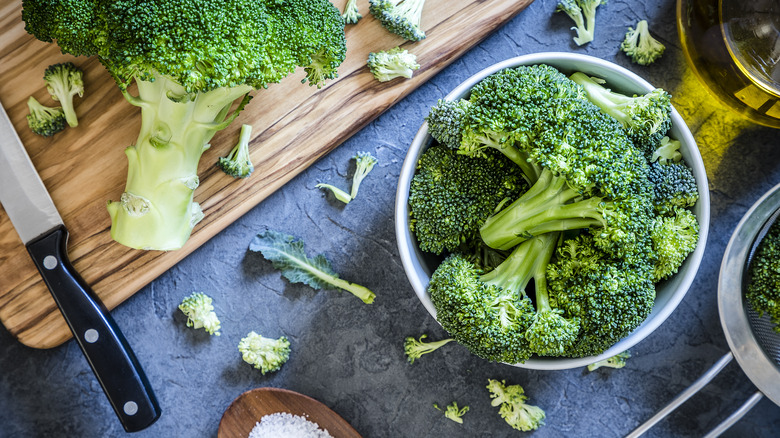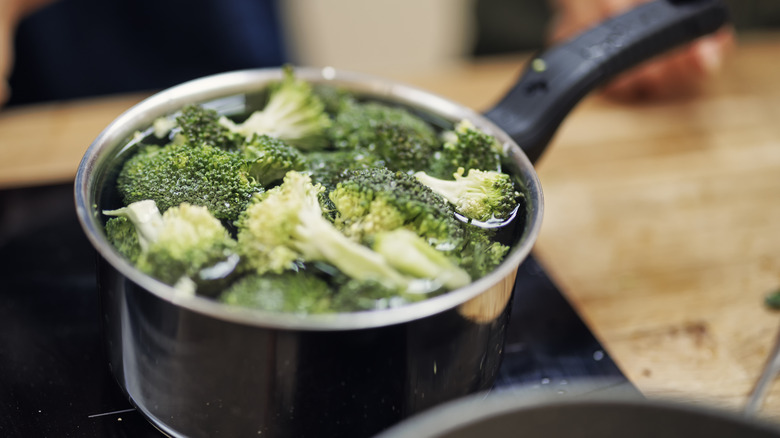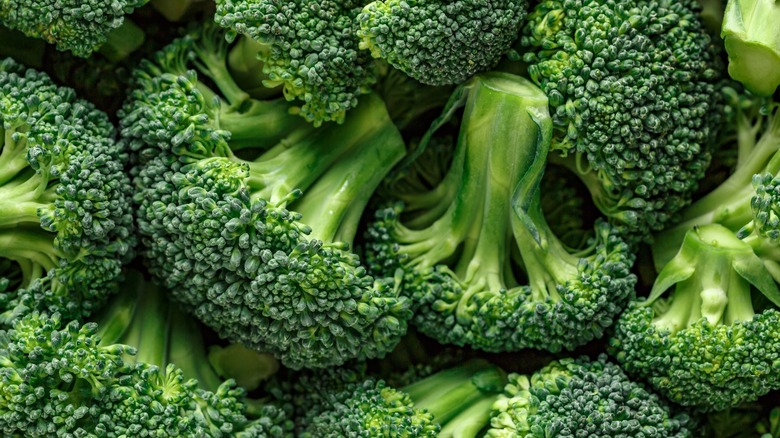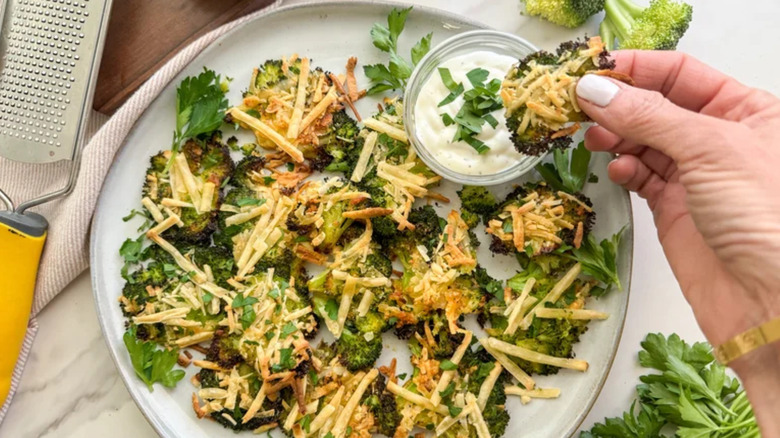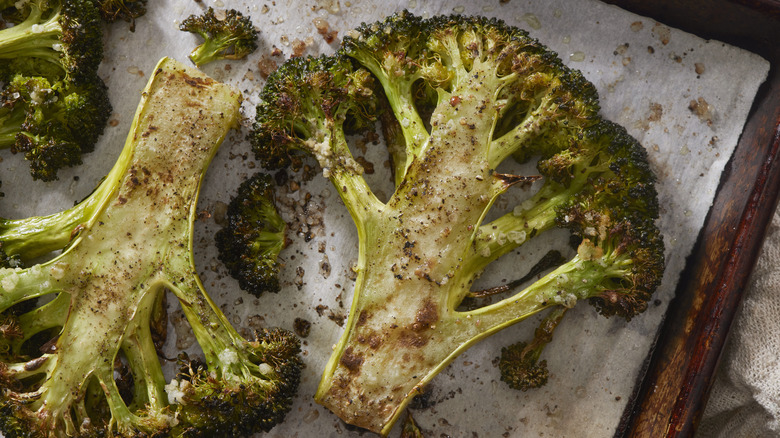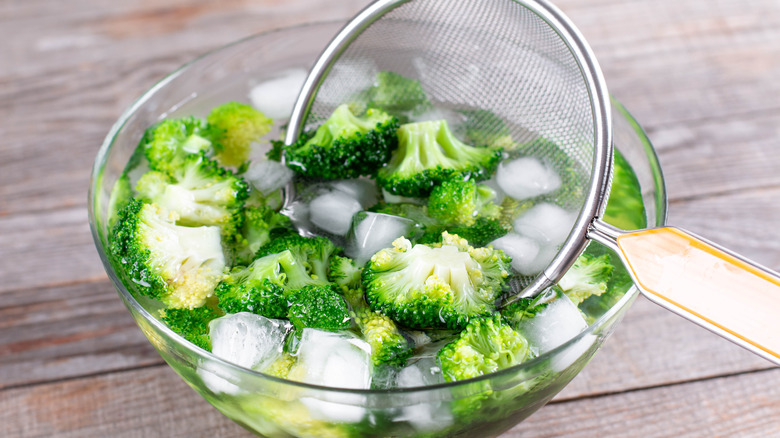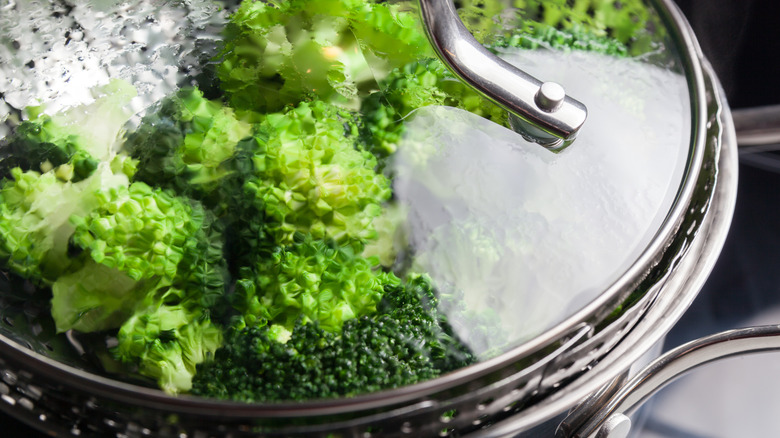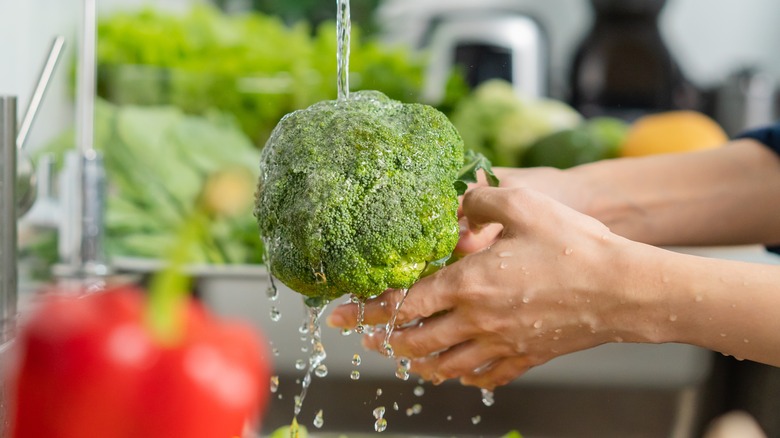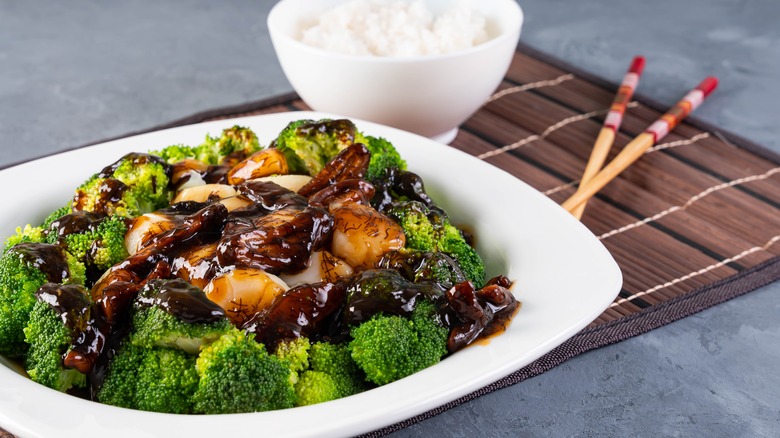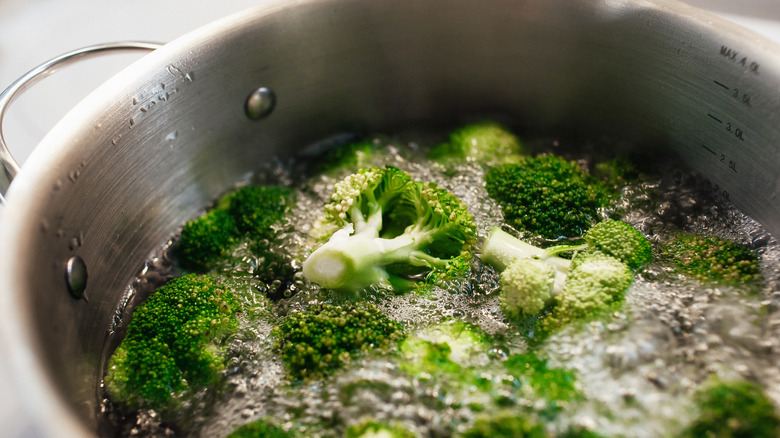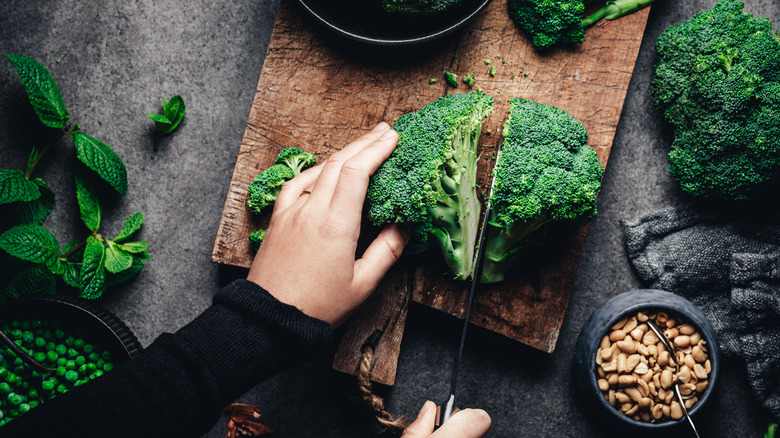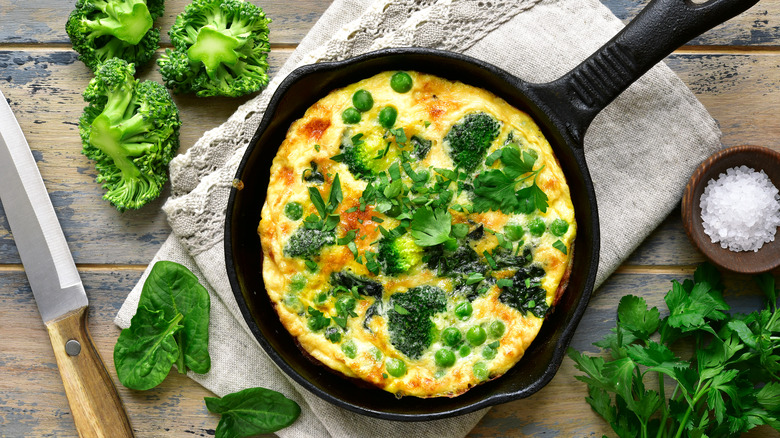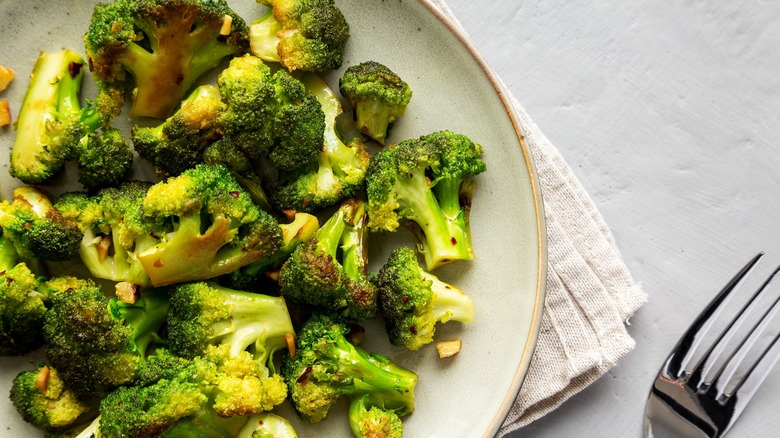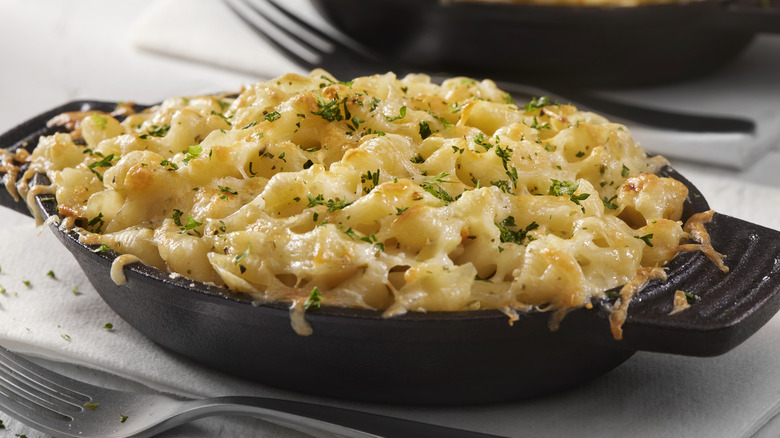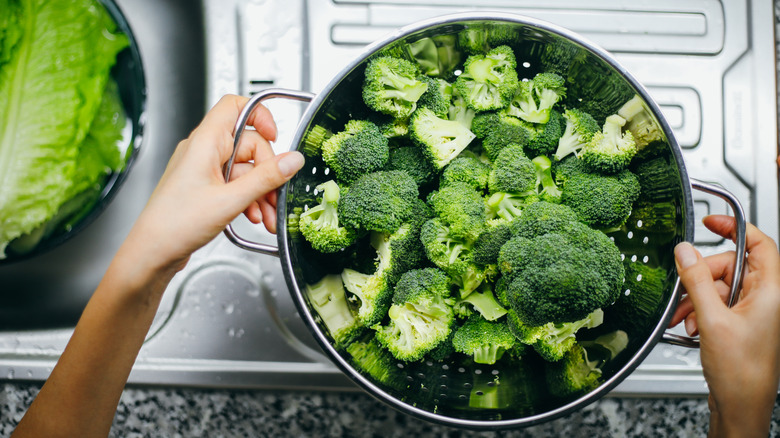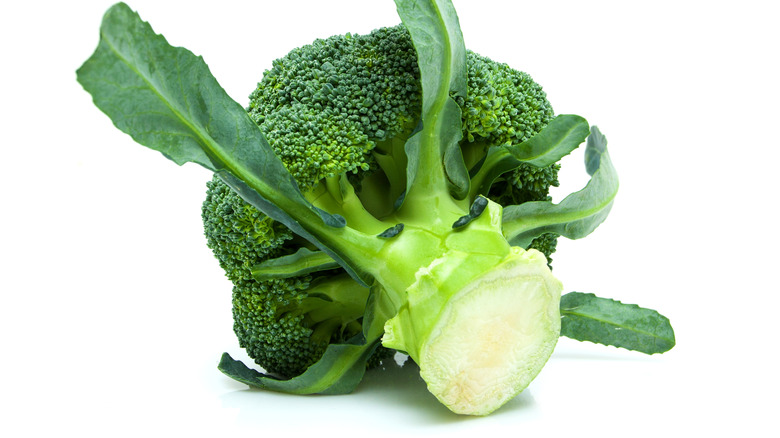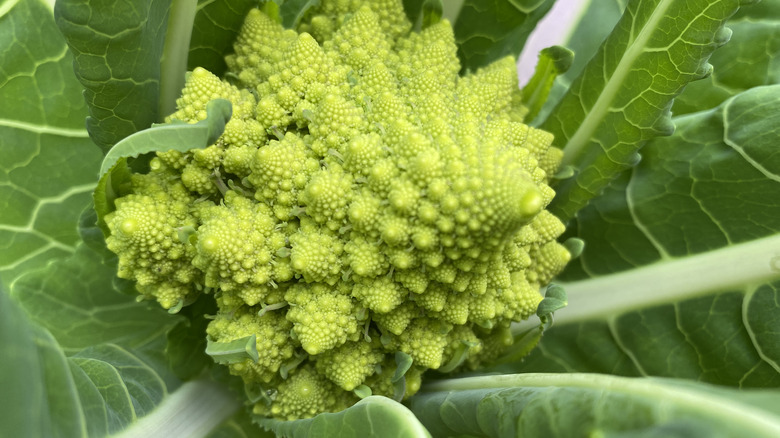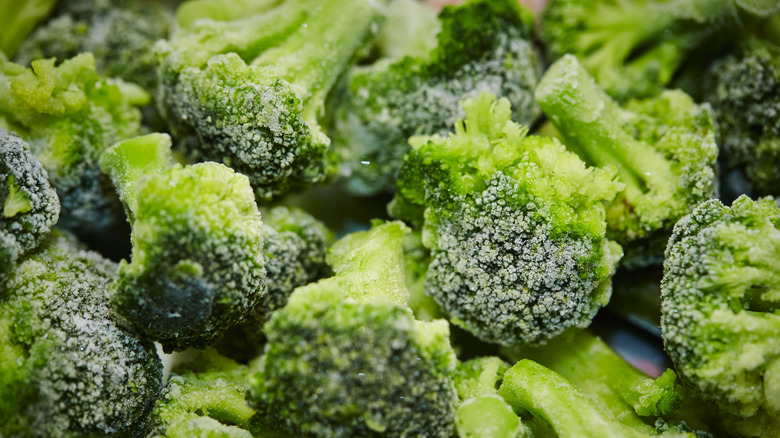18 Mistakes Everyone Makes When Cooking Broccoli
Since Thomas Jefferson introduced broccoli to the U.S. in the 18th century, this close relation to cabbage has inspired a love-hate relationship in Americans. In the beginning, xenophobic reactions to broccoli's Southern Italian origins caused many people to stay away from it. It only became commonly eaten in the 1920s when large numbers of Italian immigrants arrived in the country. They brought their appetite for broccoli and native cuisine with them, which slowly changed the public's feelings about the vegetable as it became more widespread.
Broccoli still incites strong feelings in people today. Broccoli lovers can't get enough of this delicious cruciferous superfood, while broccoli haters would be hard pressed to seek out more of what was probably a bland and uninspiring mushy mess the last time they tried it. In fact, studies reflect our complicated relationship to this hardy green vegetable. In 2022, PR Newswire reported a Green Giant survey revealing that the most popular vegetable in the U.S. was broccoli, but informal queries and a quick Google search will turn up a strong association between broccoli and the most hated vegetables, perhaps from people forced to eat the above-mentioned mushy specimens as children before they could leave the table.
It's not broccoli's fault. Overcooking is a great way to ruin broccoli, changing the color, texture, and taste, as well as the likelihood of the diner trying it again. Read on to learn what common broccoli cooking mistakes to avoid to ensure a love-love relationship with this underappreciated vegetable.
Overcooking broccoli
If you're a broccoli hater, it's possible you just don't like the taste of this vegetable. But we'd bet that many of you have sworn off broccoli after only encountering wet, mushy, limp specimens with a dull color and an uninspiring taste. Now, there are certain times you actually want to overcook broccoli ─ in some purée or soup recipes, for example ─ but the majority of time this will wreak havoc on your taste buds.
Broccoli that is not overcooked retains its bright green color, its fresh taste, and a bit of crunch that can be dialed up or down according to how long you cook it, as long as the number of minutes stays north of overcooked territory. No matter which method you choose, keep a close eye on it when it's cooking and test it with a fork along the way. You want to feel some resistance when piercing the stalk.
Picking old broccoli
If you want to minimize a bad broccoli outcome right out of the gate, make sure to choose fresh broccoli for your recipes. This vegetable is easily found in most American supermarkets all year, but when buying local, it's best to purchase it when it's in season to avoid produce that's been stored or transported far. In states like California and Arizona broccoli is in season year-round, but in other states the growing season is limited to certain months.
When choosing broccoli, give the stalk a squeeze. It should be firm and without discoloration, and if the cut end is brown and dry, it's been around the block a time or two. The florets making up the crown should be green, not yellow, and not budding. Inspect both the top and underside of the crown and definitely avoid any pieces with mold or ─ worst case scenario ─ worms.
Ignoring unique recipes
Broccoli gets a bad rap. While its potential to impress is high, it's often downright hated because of the way it's cooked. Don't let mushy, gray, and bland broccoli scare you away for good. It would be a mistake not to wander off the beaten path when deciding how to prepare this underappreciated vegetable. First things first: A good smashed and roasted broccoli dish just may change your life. When sliced thin and roasted in oil, salt, and optional spices until crispy and caramelized, it will show a seductive side you never suspected it was hiding.
With a little creativity, it's easy to make broccoli the star of the show that keeps you coming back for more. Have you heard of broccoli pesto? Broccoli Caesar? Broccoli burgers? What about mashed broccoli, broccoli slaw, broccoli melt, broccoli toast, or broccoli hummus? For beginners, try slathering broccoli in cheese or cooking it in a frittata.
Not roasting broccoli
Not roasting broccoli is a mistake. Why? One word: caramelization. The natural sugars in broccoli caramelize when heated to high temperatures, transforming very ordinary broccoli to a delightfully browned, crispy and slightly sweet version of itself with a flavor that's off the charts. There's a reason roasting is considered by many people to be the number one broccoli cooking method. Broccoli haters, ask yourself this important question: Have you had it roasted?
To make your roasted broccoli dish you'll need a hot preheated oven, and a pinch of sugar to add to your broccoli seasoning if you're aiming for a touch more caramelization (but that's optional). For maximum satisfying crispness, cut the broccoli florets and stalks into thin steaks before tossing with oil and seasoning, like in this broccoli steaks with romesco recipe. To add even more fun, consider using some of these ingredients to elevate roasted broccoli.
Not using an ice bath
Blanching and boiling are two cooking methods that are commonly used to prepare this hardy green vegetable. They both involve submersion in boiling water, but the difference is that blanching is much quicker. While broccoli can be boiled for several minutes, blanching maxes out at around 30-60 seconds. Blanching and boiling will turn broccoli a vibrant green and maintain its pleasant natural flavor as long as you don't fall asleep at the switch and commit that most dreadful of broccoli sins: over boiling.
To avoid this unsavory outcome, quickly submerge the broccoli in a bowl of the coldest ice water you can make. This is called shocking, and while there are some things that are best treated delicately, it's a mistake not to shock blanched or boiled broccoli. The ice bath will stop the cooking, preserving the broccoli's delicious crispness and keeping mushiness at bay.
Thinking broccoli has to be complicated
With so many options available when it comes to preparing this humble green vegetable, it can be easy to think that broccoli requires a complicated method or ingredient list. This is a mistake, because there is one very easy way to cook broccoli: steaming. Simple steamed broccoli requires just broccoli and water, and less than 10 minutes to make.
Place bite-sized pieces of broccoli inside a steamer basket above a cup of boiling water in a covered pot, and cook it for about three minutes. The nutrients aren't lost when you drain the boiling water since the broccoli doesn't come into contact with it. Steamed broccoli also has a neutral, fresh taste, making it a blank canvas for numerous dressings. Try tossing it with olive oil, lemon, salt, and pepper, or get creative with options like Parmesan cheese, garlic butter, fresh herbs, soy sauce, ginger, or chopped nuts.
Pan-frying wet broccoli
Don't make the mistake of trying to pan-fry, sauté, or stir-fry wet broccoli. These techniques cook food in a little oil in a hot pan, and the ideal finished texture of the broccoli is crisp. Using wet vegetables will make a soggy stir fry because rather than flash cooking it in the hot oil, which infuses the vegetables with flavor and keeps the exterior crunchy and caramelized, the ingredients will stew in the excess water and soften instead. It will also dampen the broccoli's flavor.
To avoid mushy broccoli, remove the extra water from the vegetable by draining it well and patting it dry before it goes anywhere near the pan. Take note that this tip goes for marinades, too. Marinating broccoli gives it some serious flavor, but don't add extra to the pan beyond what is already coating the pieces, or it will steam.
Limiting cooking methods
If you're in a broccoli slump, it could be that the cooking methods you've tried just aren't cutting it. Unless you're already making amazing broccoli, it's a mistake to stick to just one way of preparing and serving the vegetable (and even if your broccoli is off the charts, you may discover new techniques to love).
Roasting and sautéing are top-rated ways to cook broccoli, and while some people have strong feelings about why you should never boil broccoli, even boiled or blanched broccoli has its moments if you take care not to overcook it. Like roasting, stir-frying is a delicious way to create crispy, caramelized broccoli with a full flavor punch. If you like fried foods but could do without the oil, pop those florets in the air fryer for a similar effect. Steaming, on the other hand, is often seen as the healthiest prep method.
Losing the nutrients
Broccoli isn't called a superfood for nothing. With its high fiber and low calorie content, and formidable list of antioxidants, vitamins, and minerals including potassim, iron, folate, and vitamin C (per Healthline), it would be a shame to eat it without all the nutritional benefits. The water-soluble vitamins in broccoli leach out into the cooking water whenyou boil it, so all the good stuff literally goes right down the drain.
If you're going to consume the liquid, for example if you're making a broccoli soup, then cooking it in water is fine. Otherwise, consider steaming broccoli, since studies show that steamed broccoli retains the most nutrients. As the broccoli sits above the boiling water in a steaming basket, it cooks in the steam without needing to be submerged. For last-minute steamed vegetables, you can steam broccoli in the microwave with a few tablespoons of water.
Chopping broccoli the wrong way
If you find cutting firm, woody broccoli stems annoying, or even more so, cleaning up the scattered mess of tiny buds that come loose when you cut the florets, then avoid this broccoli-chopping mistake to make slicing easier and cleanup a breeze. All you have to do is boil the whole head of broccoli for about five minutes until it's tender but retains some firmness. Alternatively, you can steam it to retain the water-soluble vitamins.
Drain the water, handling the hot broccoli carefully with tongs, and then cut the now-softened broccoli. As a bonus, all the tiny floret pieces will have drained away with the water. This trick makes even more sense if you're going to be heating up water anyway to boil, blanch, or steam the broccoli. You'll just switch up the order. Instead of cutting then cooking, you'll do it the other way around.
Not eating broccoli for breakfast
Don't make the mistake of never trying broccoli for breakfast. Cooked into scrumptious breakfast recipes you're probably already eating, you can add more flavor and a huge boost in nutrition to the start of your day. Casseroles are a popular dinner choice, but cook up an eggy and cheesy breakfast casserole and include ─ you guessed it ─ broccoli. The same goes for that frittata you were planning for brunch. A quick tip: Recipes for spinach frittata can easily be reworked by substituting broccoli for spinach.
Broccoli muffins are pretty much just mini versions of casserole with all the same cheesy goodness, but they're great for prepping meals ahead (you can make a large batch and freeze them for subsequent weeks), and they're very convenient for grabbing on the go. Broccoli is also easy to add to omelets, or sneaking into deep-fried scrambled eggs for a decadent start to the day.
Not sautéing broccoli
Besides roasting, sautéing is considered one of the best ways to cook broccoli. Sautéing is done in a hot pan with just a little oil. The high heat and lack of excess moisture create a delectably crispy and caramelized crust that, along with salt (at the minimum) and other optional ingredients, simply takes the flavor to the next level. Another bonus is you don't have to endure longer roasting times or wait for the water to boil.
Simply heat some oil in a pan on medium high, and then place bite-sized pieces of broccoli in the pan. Try to cut them all to the same size and thickness so they cook evenly. Stir occasionally, but mostly let them rest in the pan so they get a chance to brown and caramelize on contact with the hot surface. They'll be done after a few minutes when tender to the fork.
Not sneaking it in where you can
It can be hard to get picky eaters to try something they're convinced they don't want, so a little ingenuity in concealing broccoli in more popular dishes may be the trick you need to sneak in that extra nutrition. While there's always the chance that picky children (and adults) may identify the source of the green in their food, hopefully the tasty meal will be enough distraction to let that pass. Try a broccoli grilled cheese sandwich if you dare, or hide small pieces in macaroni and cheese. Processing the broccoli first may help make it less obvious.
It helps if the dish has other ingredients to take the focus off the broccoli, so a frittata, casserole, or pasta sauce will fit the bill. Process the broccoli into small bits and blend it with other vegetables and herbs so the chunks don't stand out.
Not eating broccoli for dessert
Yes, you read that right. Don't be afraid to add this nutritious vegetable to your scrumptious desserts. We promise they won't taste like broccoli. How about a chocolate cake? Baked with other more traditional ingredients like flour, milk, cocoa powder, chocolate chips, butter, and sugar, the result is delicious and you'll never suspect all the vitamins and minerals that are hiding inside. Broccoli brownies call for cooked, puréed broccoli. They turn out moist and tasty with fewer calories and much more fiber than a regular dessert.
You can make chocolate broccoli muffins by simply adding broccoli to a store-bought chocolate cake mix and baking them in a muffin tin. Mince the broccoli so the pieces aren't noticeable. And last but not least, make broccoli ice cream by quickly processing frozen bananas, frozen berries, milk, dates, cocoa powder, and riced broccoli. Try it to believe it.
Using the wrong boiling method
We know we said boiling broccoli is not ideal because it lowers the nutritional content and because it's so easy to cross the line between perfect broccoli and soggy, overdone mess. However, sometimes boiling is a desirable method. Correctly boiled broccoli turns a vibrant green color and has a pleasant, natural taste that's a great base for dressings.
Avoiding common boiling mistakes will keep your dish palatable. Bring a large pot of water to a boil, and salt the water if you want to give the broccoli more flavor. Once it's boiling rapidly, add the broccoli to the pot. While five minutes is often recommended for boiling broccoli, test it by piercing it with a fork along the way to check the tenderness status. Two to three minutes may be preferable to keep it pleasantly crisp. When it's done, submerge it in an ice bath to stop the cooking.
Discarding the broccoli stalks
Depending on where you shop, broccoli these days is often sold as crowns with the stalks removed, or as pre-cut florets in plastic bags. The stalks, however, are completely edible and have even more fiber than the crowns, so we recommend you grab them if you can find them. Some people are discouraged by the tough or woody outer layer covering the stalk, but there's an easy fix. Carefully cut away the outermost part to reveal the interior of the stalk, which is much more moist and tender.
Slice the peeled stalks and cook them using your preferred method along with the florets. You can also roast broccoli stalks instead of throwing them out. They'll turn out caramelized and crispy on the outside and creamy and slightly sweet inside. You can use the stems in vegetable broth too (just chop them, no need to peel first).
Disregarding other broccoli varieties
With its thick, woody stem and tightly clustered florets making up the large crown, Calabrese broccoli, the most common kind on offer in supermarkets, is what many of us think of when we hear the word broccoli. But this variety is far from the only kind available, and limiting ourselves to one kind means we could miss out on varieties we might even enjoy more.
Gardeners can grow numerous varieties with enticing names like green magic, destiny, fiesta, and Apollo, and you may find some of these at local farmers' markets in various colors, including purple. If you're shopping in stores, keep an eye out for broccolini. The difference between broccoli and broccolini is that the latter has thinner stems, smaller florets, and a sweeter, milder taste. Pick up a head of very cool Romanesco broccoli if you see it; Romanesco florets look like spiral Fibonacci sequences.
Avoiding frozen broccoli
Studies show that frozen vegetables are just as nutritious as their fresh counterparts, or even more so. Frozen vegetables are picked and packaged right after harvest and sometimes while a little underripe, which preserves more nutrients, whereas fresh produce can deteriorate during transportation and sitting out. While the taste of in-season farmers' market produce can't be beat (not to mention there's the added bonus of supporting local farmers), that kind of selection isn't always available. Additionally, the time and effort required to prepare and cook fresh vegetables discourages some people from including broccoli in their diets.
Given its health benefits, it would be a mistake to avoid frozen broccoli and eat no broccoli at all. Frozen broccoli can be cheaper and more convenient, saving us time on meal prep, and it can be stored for a long time so it's always ready when we need it.
Static Media owns and operates Tasting Table and The Daily Meal.
